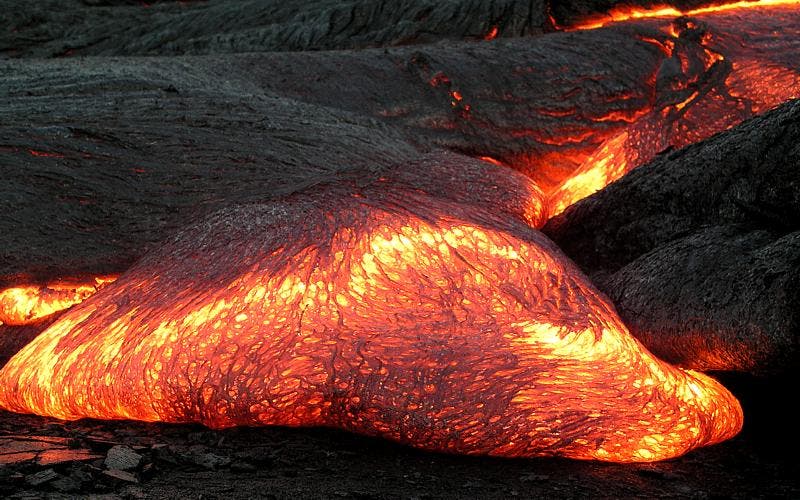Lava and magma are two terms that are often used interchangeably, but they refer to distinct stages in the lifecycle of molten rock.
We can discuss the differences between lava and magma from multiple perspectives, but the most straightforward way is to think about it this way: magma is molten rock that is still beneath the Earth’s surface; you can never really see magma. Lava, on the other hand, is magma that has made its way through the cracks and fissures in the planet’s volcanic system and reached the surface.
Magma is a precursor to lava, and lava is what we see on the surface. Both magma and lava are fascinating and powerful in their own ways, and there are multiple types of magma and lava — let’s look at them in more detail.
Lava flow on Hawaii. Lava is the extrusive equivalent of magma. Image via Hawaii Volcano Observatory (DAS)
What is magma
Magma is a complex mixture of molten rock (or partially molten rock) that lies beneath the Earth’s surface. Magma is a crucial component of the geological processes that shape our planet, and studying it offers clues to the inner working of the Earth.
Magma is, usually, a complex mixture. Generally speaking, it has three main components:
- melt;
- solids;
- and volatiles.
The ‘melt’ refers to the rocks and minerals that have been melted by the hot temperatures in the magma. Sometimes, this melt is split into the melt and other minerals crystallized in the melt. The solids are the rocks and minerals that are taken along with the rest of the magma but are still solid. Meanwhile, the volatiles dissolved gases.
Magma forms tens of kilometers beneath the surface, either in the mantle or deep in the crust, where the temperature and pressure are high enough to power its formation. Magma is commonly formed in subduction zones, continental rift areas, mid-ocean ridges, and hotspots.
“The generation of magma occurs deep within the Earth and is thus out of the range of direct observations. This process involves the melting of a solid material (source rocks) to yield a melt phase that segregates and rises to the surface buoyantly,” say Joan Marti and Gerald Erns, authors of a book on volcanoes.
The exact composition of magma depends on the type of rock it originates from, as well as the conditions beneath the Earth’s surface. For instance, basaltic magma, which is common in places like Hawaii or Iceland, is relatively rich in iron and low in silica, while andesitic magma, commonly found in the Pacific Northwest, has a higher silica content.
Magma develops and accumulates in areas called magma chambers, and can migrate toward the surface when it is less dense than the surrounding rocks. However, if it starts to rise, it encounters lower and lower temperatures, where it may start to solidify — and it often does, even before it reaches the surface. Typically, the slower the magma cools down, the larger the crystals it forms. The igneous rocks with the largest crystals are the ones that have taken the longest to cool down
If magma does reach the surface, then it can accumulate in a chamber closer to the surface, create a volcano, and erupt towards the surface, where it becomes — you’ve guessed it — lava.

What is lava
It’s not like something fundamental changes when the magma reaches the surface — it’s more a naming convention than a physical difference. What is different however is that magma generally sits in hot chambers, and when it reaches the surface and becomes lava, it quickly solidifies due to the much lower temperatures.
“Virtually all magma is generated by the partial melting of source rocks, either in the upper mantle or crust. In order for magma to be erupted [and become lava], it must separate from the residual source material and make its way towards the surface,” explain Marti and Ernst.
Lava is made up of crystals, glass, and dissolved gases. As it gets to the surface, it erupts in a slush of these elements, but unlike magma, it cools down much quicker (which means it typically forms smaller crystals).
Just like there are different types of magma, there are also different types of lava. The different type of lava also impacts how a volcano erupts — and the differences can be striking. Some volcanoes, like the ones in Hawaii, produce a runny, calm flow of lava. These volcanoes have basaltic-type, or mafic magma. This type of magma contains under 63% silica, and it produces silica-poor lava that flows smoothly. Meanwhile, silica-rich magmas, with over 63% silica, produce andesitic-type lavas that can erupt with a big bang. This also has consequences for how the lava flows and how the volcanic eruption takes shape.
“[Some volcanoes] are built from a lava that is so thick and pasty that the volcanoes’ flanks are too steep and rugged for human access. By contrast, the volcanoes of Hawai’i are built from a thin, runny type of lava that produces a mountain with gentle, readily accessible slopes,” writes Wendell A. Duffield, a USGS geologist.
“Volcanic eruptions can be divided into two main classes: effusive and explosive. An effusive eruption is one in which the molten rock called magma, rising from the deep interior of the Earth, flows out of a vent as a coherent liquid called lava. An explosive eruption is one in which the magmatic material is torn apart as it erupts into pieces called pyroclasts,” explain volcano experts Liz Parfitt and Lionel Wilson
So technically, lava is any molten rock expelled by a volcano in any way. But the rocks formed immediately through cooling are also called lava, which can be a little bit confusing. To make things even worse, a moving, outpouring of lava is called a lava flow — but that’s often referred to as simply ‘lava’. Most often though, we refer to lava as a singular flow or eruption.

The difference between lava and magma
The deeper you get into geology, the more complex this question actually becomes. There can be temperature differences between the two (magma can get a bit hotter), and the interaction with surface elements like air or water can also cause differences. There’s also a debate as to when exactly does magma become lava — at what point in its movement toward the surface — but unless you want to truly study geology, there’s no real reason to bother with that.
Unless you want to get your hands really dirty, just call it magma when it’s beneath the ground, and lava when it erupts. Lava is the extrusive equivalent of magma, it’s what we see on the surface. Magma is in the depths.
Both are important, both are powerful, both play a role on the planet. No doubt, both will continue to fascinate laypeople and geologists for a very long time to come.
“The awesome power and beauty of volcanic eruptions epitomize the global magma/igneous rock system,” writes geologist Eric Middlemost. “As one observes the spectacular ejection of incandescent material, and feels the heat of the and harmonic tremor, one senses the presence of hot, pulsating molten material gushing up from within the Earth.”







